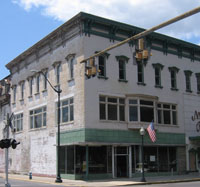
Southeast corner of Market and Third Streets:
 |
~ Lorenzo da Ponte's brick building. Lorenzo da Ponte was born in 1794 to an Italian Jew in Ceneda, Venice. He was first named Emanuele Conegliano, but when his father converted to Christianity and the two of them were baptized the young boy took the name of the Bishop who had baptized them. As a young adult, da Ponte was banished from Venice and so in 1782 accepted a post in Venna at the Court of the Emperor, Joseph II. |
In this position he met many literati and musicians and between 1779 and 1804 he wrote or adapted librettos for nineteen operas, four of which were composed by Mozart: Figaro, Cosi fan Tutte, Le Sposo Deluso, and Don Giovanni. The most famous, Don Giovanni, considered by some to be the world’s greatest work of art, was an autobiography of da Ponte himself.
After Joseph II died in 1790 da Ponte spent a brief period of time in London with the Drury Lane Theatre. Here da Ponte found himself arrested by the debtor’s courts no less than thirty times and in seeking an escape, used what little funds he had to send his wife, Ann Celestine Grahl, and his children to New York. Eventually da Ponte was able to smuggle onto a freight vessel headed for Philadelphia and in 1805 the family united in New York. Ann Grahl’s parents, Dr. Peter Grahl and Mrs. Louisa Nicolini, were already residing in Sunbury by this time and so in 1811 after meeting early financial success in America, the da Ponte family found their way to Sunbury.
In 1814 da Ponte built a three story brick home, which was for years the only three story building in the County. He also attempted a musical college, kept a general store, and partnered with a distiller for short periods of time. Unable to establish a steady source of income, da Ponte returned to New York in 1819 and at the age of seventy became a professor of Italian literature at Columbia College. Here he introduced America to the Italian opera. Da Ponte died in 1838, thirty-three years after his arrival in Philadelphia.
Corner of Market Street and Center Ally:
~ The Jail and the Courthouse. In 1774 the colonial legislature granted 800 pounds to the County of Northumberland to build a courthouse and a prison. The building began in 1775 and was finished a year later. Stone and brick were used for construction and one side was made into a jail while the other served as a courthouse. This lasted for twenty years until 1797 when a two story brick courthouse was constructed in the west end of the square near Second Street. The construction of a new courthouse led to talk of building of a new jail. Thus in 1801 a lot was purchased on the corner of present day Arch and Second Streets and a jail was built. The original joint building was later used for printing offices and also served as a store known as the Pleasants House.